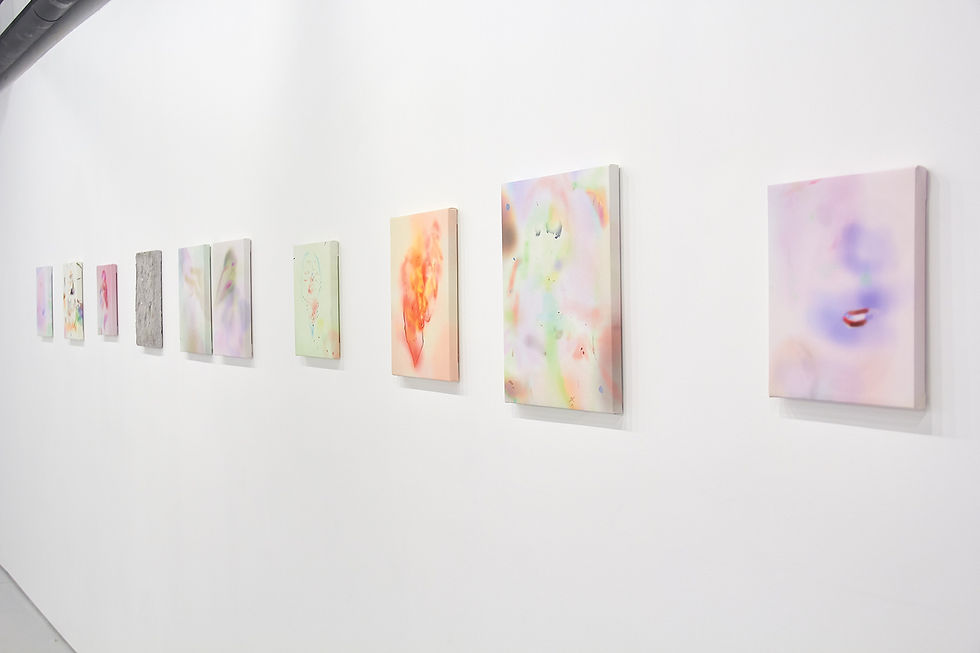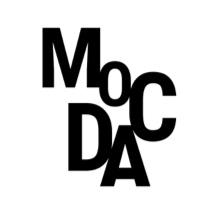Travis LeRoy Southworth
- MoCDA Team

- May 29, 2020
- 6 min read
Imperfections Made Perfect
In The Studio with artist Travis LeRoy Southworth by Fanny Lakoubay

Travis LeRoy Southworth in his Manhattan Studio, NYC.
Photo credit: Anna Bauer
MY STORY WITH SOUTHWORTH
Travis and I met at a blockchain conference, Ethereal Summit 2018, where he was exhibiting one of his prints on silk at the art+blockchain exhibition held by Codex Protocol. The ethereal name of the conference was perfect for Travis’s style.
He sold his work Please cheat the color at the art auction that closed the conference, the exact same auction where a CryptoKitty was sold for $140,000 famously covered by the NYTimes. Travis’s work was sold in the “silent” part of the auction, which means that there was no public live bidding in the room on his lot, but people could bid on the work online, via LiveAuctioneer, where the lot is still listed.

Travis LeRoy Southworth
“Please cheat the color” (2016), 40 x 30 inches, pigmented print on silk. See lot on Liveauctioneer
A little bit later, in the summer of 2018, I went to the Greenpoint open art studios where SuperRare, a blockchain-based art marketplace, exhibited his digital works on their platform along with one of his beautiful prints on silk, floating in the draft of a typical Brooklyn warehouse converted into small coworking spaces.
At CADAF digital art fair first edition in New York in May 2019, Travis surprised me with his submission of a very different video art piece, “Absent Minded Monotonous Splendor”, 2010, which is very minimalist, almost disturbing even, as it shows a white screen slowly taking over his own face to only feature skin imperfections, a much less ethereal, more down to earth and critical piece. See Travis’s submission to cadaf art fair
This is when I realized I had no idea about his work process or the story behind his work, just knew he was a photo retoucher and a dad in real life. If you click on any of the above links, you’ll quickly realize that the websites don’t spend much time or effort to understand the works and even less to tell a story around him or his work. Newsflash: this is how Christie’s is so successful: storytelling.
So let me tell you Travis’s work story that I learnt recently at his midtown Manhattan studio / showroom one busy evening after fighting my way through commuters hurrying back home out of Manhattan.

WHERE DOES SOUTHWORTH’S INSPIRATION COME FROM?
As mentioned, Travis is a photo-retoucher by trade in the fashion industry. (Go to LinkedIn for the details). As such, he edits thousands of fashion shots, portraits of models every month, mostly editing out the model’s imperfections, such as cellulose on a leg, pimples on the chin, wrinkles on the forehead. You get it… But what if we could keep ONLY the human imperfections and edit the rest out. Travis explores these acts of removal via a very different series “Detouched” which predates the current work but is all linked together.
“By collecting the erased bits of photographic portraits, Southworth, like Whiteread, forces us to look at that which we do not want to see. Like Rauschenberg, he forces us to question what it means to erase.”
Lorrie Fredette & Beth Giacummo, Exhibition “The act of erasure”
WHAT TOOLS AND MEDIA DOES HE WORK WITH?
Travis reworks and modifies digital photographs in Photoshop, moving bits of skin, removing the backgrounds, and altering colors to produce a final digital file that is closer to a painting than the original photograph. He was sharing with me that his process often involves working on a large number of artwork files at the same time, reworking them, letting them aside, and going back to them after a while.
Travis then translates his finished work onto different media, such as a digital file uploaded onto blockchain-based marketplaces like SuperRare, to make them scarce editions or “rare art”. He also prints them on various types of fabric (from satin to a more traditional surface like canvas) to exhibit at galleries or art fairs. The medium that he is currently exploring is to print on silk and hang it on a twisted steel wire that shapes the silk into a ghostly form, changing with the wind or the inspiration of the artist. This 3D aspect + the wire hanging gives another dimension to the printed work that comes to life.
“I am interested in sculpture as I start from a real person that is translated into a photograph. I modify and distort this image digitally to be printed on a two-dimensional fabric, that is shaped, folded and brought back to a physical space.” Travis LeRoy Southworth

I Am A Portrait- solo show at Undercurrent, Brooklyn, NY
WHAT ARE SOME SERIES WORTH MENTIONING? COLOR, BALANCE
What it is: “Color, Balance” is Southworth’s series of colorful paintings that he began in 2016. His starting point is a fashion photo shoot that he used or edited in his daytime job working for the advertising industry. With Photoshop, he modifies forms, accentuates colors, erases the model who posed for the work to only retain imperfect elements of the person and abstract forms. Each piece is a unique work and he uses a variety of supports, such as canvas, paper, or silk.
Where do the artwork titles come from: While editing the photographs at his job, Travis interacts with many stakeholders from the fashion industry, such as the model, art director, agency and client; who all have comments on the images and what needs to be reworked, retouched, or taken out. It is in these comments that Travis finds inspiration for the titles in this series: “Dirty Neck”, “They all can't be winners”, “Try not to make it look like a coke party”
What it looks like:
I Am A Portrait- solo show at Undercurrent, Brooklyn, NY

I Am A Portrait- solo show at Undercurrent, Brooklyn, NY
Travis LeRoy Southworth
DETOUCHED
What it is: An earlier body of work from 2007-15 that inspired the later “Color, Balance” series. Here Southworth only kept the imperfections of the portrait photography he edited, moved things around and erased everything else. Keeping as art what everybody edits out in the advertising industry. Southworth’s “Detouched” portraits look like outer space landscapes shaped from fragments of human flesh. It’s almost as if he was mixing cosmology and cosmetology.
Similar video piece: His video piece, Absent-Minded-Monotonous-Splendor plays on the same idea of a face being erased and for its imperfections to be the only thing left.
Travis LeRoy Southworth (b. 1979) “Absent Minded Monotonous Splendor” (2010)
Digital video, 3 minutes 30 seconds A video project that animates the erasure and ultimate explosion of a portrait. Over the course of the animation, a face dissolves and is swallowed by the white of the screen leaving only blemishes, wrinkles and stray hairs. These "imperfections" become animated and simulate a possible big bang. The video highlights the more tedious and absurd aspects of digital manipulation while relating to the birth of the universe.
What it looks like:
Detouched - detail from exhibition Compendium at The Islip Art Museum
Travis LeRoy Southworth
THE CONTINUOUS WORK DRAWINGS (DOUBLE DIP)
What it is: A series of 1500 digital drawings exploring the relationship of time spent at work and time spent making art. What if Travis could do both at the same time and double dip in a way? Each drawing is created via a computer program that tracked his stylus on the tablet while retouching e-commerce photos at work and recorded as simple continuous single pixel lines. We currently talk a lot about impressive works like “machine learning”, GAN, AI, but all it takes for a great artwork is an idea that makes the viewer think. This work is exactly that: it uses simple technology to create something conceptual that exists on its own as art, with no purpose.
Where do the titles come from: Each drawing is titled with the drawing number, date created, how long it took to finish, and the time of day.
How is it done: Via a computer program that creates a digital file that is then printed on paper in black and white
What is looks like:
The Continuous Work Drawings (Double Dip)
Front and back of the drawing
NEW BEGINNINGS, OLD ENDINGS, SECRETS SECRETING
What it is: This is a new fun series on the hype around the use GAN and machine learning in art creations. Where Southworth uses a neural network to do the work for him. He feeds the machine portraits of famous people, clowns, historic paintings and tells the machine to create portraits in the same style as some of his previous works. From here Travis further manipulates the image in Photoshop. It’s almost as if the machine is dreaming with the artist’s own hopes and fears.
What it looks like:

Installation view of New Beginnings, Old Endings, Secrets Secreting
Travis LeRoy Southworth
Fat Finger, Liquify Monster
Travis LeRoy Southworth
This interview was conducted by curator
Fanny Lakoubay






























Comments